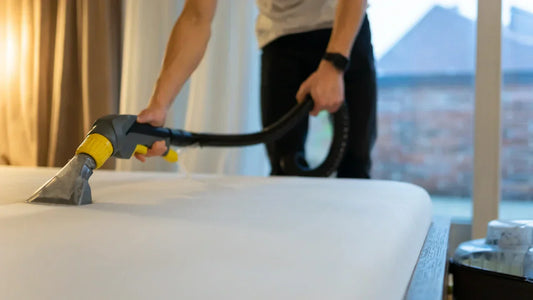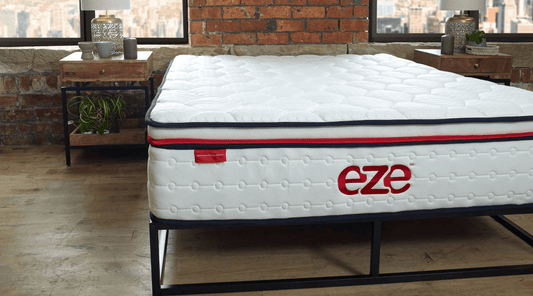Can You Put a Mattress on the Floor? Pros, Cons & What to Know
Sleeping with your mattress on the floor—is it a minimalist dream, or a fast track to mould and back pain?
Some people love the simplicity of a mattress without a bed frame, while others worry about hygiene and comfort.
So, can (and should) you put a mattress on the floor?
The answer depends on the type of mattress you have, your sleeping habits, and how you maintain it.
Let’s break down the benefits, downsides, and how to make it work if you decide to go frame-free.
Benefits of Sleeping on the Floor
First things first, why would you want to put your mattress on the floor?
Well, there are 3 main benefits of doing it:
1. It’s Free
Skipping a bed frame saves money. If you’re on a budget or living somewhere temporarily, placing your mattress directly on the floor is a cost-effective option.
And the money you save on the bed frame could mean you can invest more in a high-quality mattress, like one of our hybrid mattresses.
2. You Might Enjoy the Vibe
A low-profile bed can give your room a minimalist, modern, or Zen-inspired look.
Many people love the sleek and simple look of a mattress on the floor, especially in small spaces.
3. A Firm Surface May Help With Back Pain
For some sleepers, a firmer sleep surface can improve spinal alignment and reduce back pain.
And what’s firmer than the floor?
While hybrid and memory foam mattresses often work best with a supportive foundation, a solid floor prevents excessive sinking, which could help with posture.
Downsides of Sleeping on the Floor
There’s quite a stigma attached to sleeping on the floor. But this belief isn’t unfounded with several disadvantages you need to be aware of.
1. Low Air Circulation Can Lead to Mould Growth
The biggest issue with putting a mattress directly on the floor? Moisture buildup.
Most of the moisture in a mattress doesn’t come from the floor itself—it comes from your body as you sweat in your sleep.
Normally, a bed frame allows airflow underneath the mattress, helping it dry out.
Without ventilation, heat and humidity can trap moisture inside the mattress, creating an environment where mould and bacteria can thrive.
Tip: If you must keep your mattress on the floor, regularly lift it and let it air out.
2. It’s Easier for Bed Bugs to Get Inside the Bed
Bed bugs thrive in low, undisturbed spaces, and having your mattress on the floor makes it easier for pests to climb in.
Other small critters (depending on where you live) could also find their way into your mattress.
Tip: Vacuum around the mattress frequently and use a full-zip mattress protector to keep bugs and dust mites at bay.
3. Cultural Stigma
In some cultures, sleeping on the floor is common.
In others, it’s associated with poverty or uncleanliness.
Some people may assume that a mattress on the floor = dirty living—even if you keep your space spotless.
You might not find this an issue, but it’s worth keeping in mind if other people frequent your bedroom.
4. It Might Void Your Warranty
Many mattress brands require that their products be placed on a proper foundation to remain under warranty.
If you put a mattress directly on the floor, you might lose coverage if anything goes wrong.
You should check the warranty terms before skipping the bed frame.
What Type of Mattresses Can You Use on the Floor?
While we recommend putting a mattress on a bed frame, there are some mattress types that can work on the floor. They include:
-
Memory Foam Mattresses – Work well as long as they’re thick enough (10”+ recommended) and you take measures to prevent moisture buildup.
-
Hybrid Mattresses – Can be used on the floor, but must be rotated regularly to prevent trapped moisture.
-
Latex Mattresses – A great option for the floor, as latex naturally resists mold and dust mites better than foam.
What Type of Mattresses Shouldn’t You Use on the Floor?
-
Innerspring Mattresses – Not ideal, as they need a sturdy foundation to maintain proper support. Without a base, they can sag quickly.
-
Thin Mattresses (Under 8”) – Thin mattresses on the floor can feel too firm and uncomfortable without extra cushioning.
-
Tempur-Pedic and High-End Memory Foam – Many brands void warranties if their mattresses aren’t placed on a supportive base.
How to Make a Mattress on the Floor Work
If you’re set on keeping your mattress on the floor and prefer the vibe, follow these steps to make it more comfortable and hygienic:
-
Use a Full-Zip, Moisture-Proof Mattress Protector
A waterproof mattress protector will prevent sweat, spills, and humidity from seeping into your mattress—reducing the risk of mould and bacteria buildup.
-
Lift the Mattress Weekly to Air It Out
At least once a week, stand your mattress up against the wall to let it breathe. This helps prevent moisture from getting trapped inside.
-
Place a Rug or Pad Underneath
Adding a rug, yoga mat, or thin platform can create a small barrier between your mattress and the floor, preventing direct contact with dirt and dust.
-
Rotate & Flip the Mattress Regularly
Rotating your mattress every 3 to 6 months helps even out wear and keeps the materials from compacting too quickly.
Note that you won’t be able to flip a hybrid mattress as they are designed to be slept on in one way.
-
Consider a Low-Profile Platform or Slatted Base
If you love the low bed look, consider a minimalist platform bed instead.
Even just a few inches of elevation can improve airflow and reduce potential issues.
Final Thoughts
So, can you put a mattress on the floor? Yes—but there are pros and cons.
If you’re looking for a budget-friendly, minimalist sleep setup, placing a mattress on the floor can work with the right precautions.
However, potential downsides like mould, pests, and warranty issues should be considered before going frame-free.
If you do choose to keep your mattress on the floor, be sure to use a moisture-proof protector, lift and clean it regularly, and take steps to improve airflow.
Want the best of both worlds? Consider a low-profile platform bed for a stylish, supportive alternative.









